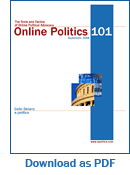Updated January, 2011

The first thing to remember about working with the news media is that reporters are bombarded with information and that the good ones consequently quickly develop a sensitive bullshit meter. When you’re working with journalists, dial back the rhetoric and focus on the facts of your issue.
The main exception is when you’re providing a statement to a reporter from which he or she will mine quotes. In that case, being over-the-top may help land you in the story. But even then, always try to back your language up with facts, usually in a “For More Information” section at the end of the statement. Everything you send to reporters should have your site’s URL!
As when you’re dealing with Congressional staff and other decision-makers, often your most-important role is to have a website that’s a good information resource. Reporters are going to start out on Google, like the rest of us, so having relevant content that’s widely linked-to is vital. Content, once again, is key.
Next, when reporters do arrive at your site, make sure that they can find what they’re looking for. General navigability is a good start, but you’ll also usually want to have a special section of the site carved out for journalists. In that section, you’ll generally have:
- press releases and statements, often divided by topic
- information about your issues, or at least clear links to your issues, factsheets and reports
- contact information for your organization’s press team
- a sign-up form for your press email list
Now that we’ve taken care of random stumblers-by, let’s get more aggressive. When you’re contacting reporters, you generally don’t want to send email attachments — they may be away from the office and reading mail over an iPhone or Blackberry or even a dial-up connection in some remote and godforsaken hotel room, and big attachments will bug the hell out of them.
Consequently, one of an online communicator’s common tasks is usually going to be supporting your press team by collecting documents that they want reporters to see and presenting them on a central page about an issue. You’ll usually have a short intro and a clearly-identified list of links of the documents (which might include press releases, video clips, congressional testimony, letters to Congress from supportive corporate CEOs or grassroots citizens groups, reports, factsheets, etc).
When you’re preparing issue pages like these, unless you’re specifically keeping them low-profile, make sure that they’re referenced on your site front page. A reporter may remember that he or she got information from you recently but not have access to the specific URL of your news release or your issue page.
One tactic we had great success with at a previous job was podcasting issue briefings. When we held a conference call or even a stand-up press event, if possible we’d record the audio and post it online as an mp3. This way, reporters who couldn’t make the initial event could still listen in, and we got several press hits from podcasts that we’d have missed if the audio hadn’t been available. And, of course, regular citizens can listen in, too, which has led to blog hits in the past.
Reporters are Bloggers (and Twitterers), Too!
A newer channel for reporter-outreach is via their ever-increasing role as bloggers and Twitterers. Many traditional news outlets now require their reporters to blog regularly throughout the day, just as many reporters have also taken to Twitter as a tool for communication and interaction. Consequently, they’re open to connection through blog comments and Twitter @replies/retweets/Direct Messages, and they may also be more hungry for short bursts of content to help fill those blog pages. I actually know of nonprofit communications staff who’ve gotten stories placed in prominent news outlets because they first contacted the relevant reporter via Twitter. Of course, as more people use Twitter and its novelty fades, this route may be pinched off, just as it’s now harder to reach many reporters via email now than it was when it was a shiny new tool.
Long-term reporter education
Beyond supporting normal press outreach, you can also create special sites or special online presentations for long-term press education. They may be straightforward presentations of information or they may be snazzy video extravaganzas, but their goal is usually to influence the way reporters approach an issue rather than to score immediate press hits.
Before I started at National Environmental Trust (now Pew Environment Group), they launched Luntzspeak.com, an excellent little site centered around a strategy memo by Republican pollster/messaging guy Frank Luntz. In the memo, Luntz suggested language that Republicans could use to improve their image on environmental issues without changing their actual policies, and the Luntzspeak site highlighted politicians’ use of his tactics for reporters. The goal: to make them skeptical of such language in the future.
Another good educational tool is to present abstract data in a way that’s easy to grasp. As an example, again, before I started as an employee, NET’s partner Clear The Air developed an online power plant pollution locator as a Flash application. The locator site shows major power plants across the country and lets you zoom in on each one to see how many tons of pollutants it produces. It also compares the effects of different plant clean-up plans. Besides putting it on the web, Clear The Air also provided its field organizers with CD copies that they could bring directly to reporters and demonstrate.
Many organizations have used Flash, Google Maps and/or Google Earth to present information in clear and compelling ways on issues ranging from the 2010 Gulf of Mexico oil spill to congressional redistricting the scourge of political robocalls to Third World political corruption to the humanitarian crisis in Darfur. One good source of inspiration is the Sunlight Foundation, an organization devoted to tracking the role of money in politics and a continuing font of interesting uses of political data.
